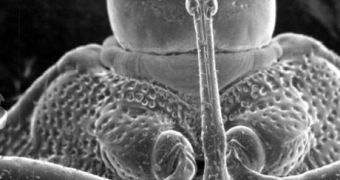The Arizona State University is hosting the 2010 Ugly Bug Contest, for the third time in a row. The public can vote its favorite insect on features such as size, color, beauty, or straight-up ugliness
“You’ve just entered another dimension – a dimension of insects, a micro dimension, where milkweed bugs, assassin bugs, crickets and fruit flies crawl, walk or fly side by side to show off features that are the envy of the insect world and quite possibly beyond,” the video introducing the contest says.
Inspired from the 1950s television series The Twilight Zone, this description is meant to introduce people to the fascinating world of magnified insect photos, which reveal in exquisite detail how the most common creatures actually look like.
When it was first introduced, the contest was a massive success. Last year alone, more than 8,000 people showed their support by casting their vote on their favorite insect.
This year's competition ends on December 15, and accepts votes on the most unique, disturbing, creepy, fascinating or detestable multi-legged creature.
Some of the bugs that “want” to take home the prize include the zombie-looking house cricket, the assassin bug, the earwig, the flour beetle, the fruit and house flies, male ants, milkweed bugs, jewel wasp and yellow dragonflies, the ASU team says.
The contest was first proposed and created by expert Marilee Sellers at the Northern Arizona University, in Flagstaff. For more than a decade, it endured as part of the Flagstaff Festival of Science and the Mount Campus Science Day.
Starting in 2008, Sellers and ASU expert Charles Kazilek decided to join forces to bring the Ugly Bug Contest to the world wide web, in collaboration with the ASU kids' site Ask A Biologist.
Thus far, the competition has already received more than 1.800 votes, and Kazilek is hopeful that more people will come and cast their votes on the insects.
He believes that one of the main reasons why the Contest is so popular is because it depicts the bugs in ways that are not normally made available to the general public.
“Most people don’t have a scanning electron microscope. The contest presents an opportunity to see these insects up close in a way that you typically are unable to,” he concludes.
Video credit: AskABiologist.com

 14 DAY TRIAL //
14 DAY TRIAL //